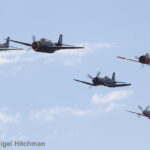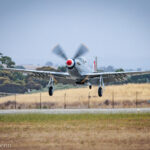By Randy Malmstrom
Since his childhood, Randy Malmstrom has had a passion for aviation history and historic military aircraft in particular. He has a particular penchant for documenting specific airframes with a highly detailed series of walk-around images and an in-depth exploration of their history, which have proved to be popular with many of those who have seen them, and we thought our readers would be equally fascinated too. This installment of Randy’s Warbird Profiles takes a look at the Erickson Aircraft Collection’s Commonwealth CA-17 Mustang, an Australian-built P-51D.

In 1943, an agreement had been reached between the Royal Australian Air Force (RAAF) and North American Aviation (NAA) whereby that company would provide unassembled kits of 100 P-51Ds, and Packard Motor Car Company would supply their U.S.-built version of the Merlin engine, and in all 80 CA-17 Mk. 20s of the 100 ordered were built and given the numbers A68-1 through A68-80.
This particular aircraft was built under license to the Australian aircraft manufacturer Commonwealth Aircraft Corporation at Fishermans Bend, Melbourne, Victoria (CAC – which went on to produce the CA-18 versions Mk. 21, 22 and 23), from a kit of semi-completed P-51D components supplied by NAA and completed as a CAC CA-17 Mk.20 Mustang. On March 3, 1945, this aircraft was delivered to the No. 1 Aircraft Depot RAAF at Laverton (a suburb of Melbourne) with the RAAF serial number A68-39. However, World War II came to an end and the aircraft was put in storage until August 6, 1947 when it was issued to No. 1 Wirelesss Air Gunners School (1WAGS) at Ballarat, Victoria until it was advertised for disposal by the Directorate of Military Disposals on December 4, 1953.
In 1954, it was acquired for 206 pounds by Wilmore Aviation Services Pty Ltd. at Moorabbin in Victoria. By October 1959, it went to Fawcett Aviation’s Illawarra Flying School in New South Wales where, between 1959 and about 1979, flew with the civil registration VH-BOY and the slogan “Fly Illawarra” on the tail fin. Under contract to the RAAF and other Australian forces, it was used in atomic bomb testing in the South Pacific and as a target tug with the name “Miss Yankee”, as a tandem two-seater with the winch operator facing aft behind the pilot. The winch protruded from the starboard side of the fuselage near the winch operator’s seat and was wind-powered by a propeller on the cable drum; the nearly one mile-long tow cable fed out a chute just forward of the tailwheel. On June 5, 1976, it ran off the end of the runway and required a rebuild.

In 1978, it was sold to Doug Arnold, the owner of Fairoaks Aviation Services (also of Warbirds of Great Britain Ltd, Blackbushe, UK; the deal included a number of other aircraft); and in 1980 was again sold to Gordon W. Plaskett of King City, CA. It remained in storage there until was sold to Bill “Tiger” Destefani of Flying Tiger Farms in Bakersfield, CA in 1981, flying it as N551D (its current FAA registry) until October of 1983, when it was restored as RAAF “A68-39/BF-D”.

In 1983, it was acquired by Jack Erickson of Erickson Air Cranes as one of his many acquisitions of former military aircraft and it was then painted as “0-7” of the U.S. Army Air Force. Erickson had been a sponsor of NAS Tillamook Museum in Oregon where it and other Erickson acquisitions were put on display. It was sold to Geoff Milne of Melbourne, Australia but he was killed when flying his Cessna 337 (from Moorabbin to Merimbula, hitting the ocean near Wilsons Promontory in Victoria) before the transaction was consummated.
Ownership was changed back to Erickson Group Ltd. until April of 2015, when it was registered to Jack Erickson’s P51 Mustang LLC and is part of the Erickson Aircraft Collection now in Madras, OR; for a time until its suspension, the Mustang had flown for a period with the Liberty Foundation’s tours.

It is painted as a Mustang of the 332d Fighter Group, the Red Tail Squadron, the great “Tuskegee Airmen” (and it appears that at least in part it is painted in honor of the 100th Fighter Squadron CO Captain Roscoe Brown). It is registered with the FAA as s/n 44-14826 as if it were a U.S.-built aircraft — this was a method used to get foreign-built military aircraft registered in the U.S. at the time the aircraft was imported.

About the author






























